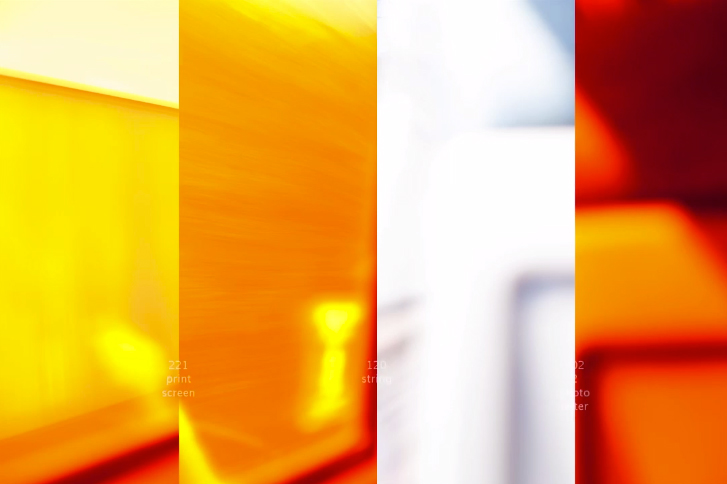
Language Overview
Commands are determined by sets of three-digit ternary numbers. Each number is a delta from one photo to the next (read alphabetically), each digit representing changes in one of three attributes: Color, Aperture, and Shutter Speed. If the value stays the same for an attribute (such as Color), it is always recorded as a 1, which always indicates no change.
- If the shutter speed becomes longer (slower), that is a 2, if the speed increases, it is a 0.
- If the aperture becomes larger (smaller f-stop number), that is a 2, the other way indicates a 0.
In other words, if the shutter or aperture change to let in more light, the number is 2.
- Color cycles Red -> Green -> Blue (wrapping around back to Red). If it progresses in this cycle, it's a 2, if it goes a step backward, it is 0.
Light Pattern works with JPEGs only, as aperture and shutter are pulled from the EXIF data. Color is the dominant color of the photo, determined by counting RGB values pixel-by-pixel.
Example of how deltas are determined
Four photos:
1/2, 6.7, Red
1, 8, Red
1, 8, Red
1/2, 9.5, Red
This would translate to:
201 : shutter speed of 2 (slower), aperture smaller (0), Color the same (1).
111 : everything stays the same (all 1s).
001 : shutter speed of 0 (faster), aperture smaller (0), Color the same (1).
This program declares a variable called 111 as an int.
Instructions
Commands
| Value | Command | Notes |
|---|---|---|
| 200 | Let | followed by variable name, then by expression |
| 201 | Declare | followed by variable name, then by type |
| 202 | While | followed by expression, then by commands |
| 210 | End While | |
| 211 | If | followed by expression, then by commands |
| 212 | Else | |
| 220 | End If | |
| 221 | ||
| 222 | Reset | Indicates that the following photo should be ignored. Used when shutter speeds get too fast or apertures too large. |
| 001 | Fork | Fork process * ** |
** works only in 2.0 compiler
Types
Used only in declarations.
| Value | Type |
|---|---|
| 001 | Int |
| 010 | Char |
| 011 | Double |
| 012 | String |
Expressions
| Value | Expression | Notes |
|---|---|---|
| 100 | Variable | followed by variable name |
| 101 | Int (+) | followed by length (in deltas), then by value |
| 102 | Int (-) | negative value – followed by length (in deltas), then by value |
| 110 | Char | followed by length (in deltas), then by value |
| 111 | Double (+) | followed by pre-decimal length, post-decimal length, then pre-decimal value, then post-decimal value |
| 112 | Double (-) | negative value – followed by pre-decimal length, post-decimal length, then pre-decimal value, then post-decimal value |
| 120 | Begin String | followed by lengths and char values for each character |
| 000 | End String | |
| 020 | Two-Code Expression Indicator | followed by another code from the Two-Code Expression list |
Two-Code Expressions
These are expressions that require two codes instead of one. The first code is the two-code expression indicator (020). These are the second codes:
| Value | Expression |
|---|---|
| 000 | == |
| 001 | > |
| 002 | < |
| 010 | NOT |
| 011 | AND |
| 012 | OR |
| 020 | ( |
| 021 | ) |
| 022 | + |
| 100 | - |
| 101 | * |
| 102 | / |
| 101 | % |
Building Programs
Light Pattern programs can be complicated to create, but the compiler provides tools to make it easier. Here's a suggested method:
1. List the numeric codes for the program you want to write, in a .lpc file, with one three-digit code per line (comments can follow, after // ). Run the compiler with a /g flag on that file. A .lp file is created, translating the codes into suggested exposure / color combinations. It assumes a camera that can shoot in half-steps, so some adjustments may be needed (keep in mind it is all delta-based, so the exact numbers don't matter as long as they're consistent).
If any "out of range" errors are reported, check the line number, and find a good place just before then to put a "222" reset command (hopefully this will be automated in future versions). This should also be used if it suggests a shutter speed that's faster than the camera you're using is capable of, or a lens with a smaller max aperture, etc.
2. Run the compiler on the .lp file with a /n flag. A /c flag can be added as well to produce a C# file rather than an executable.
3. These two steps should be repeated until the program functionality is perfect. At that point, take the list of exposures in the .lp file and shoot the images as listed. This produces the final Light Pattern program, which can be compiled with the directory name.
During compilation, the compiler writes out the color and exposure info – if anything's off, one thing to check is if the compiler's interpretation of the color is different than what you expected.